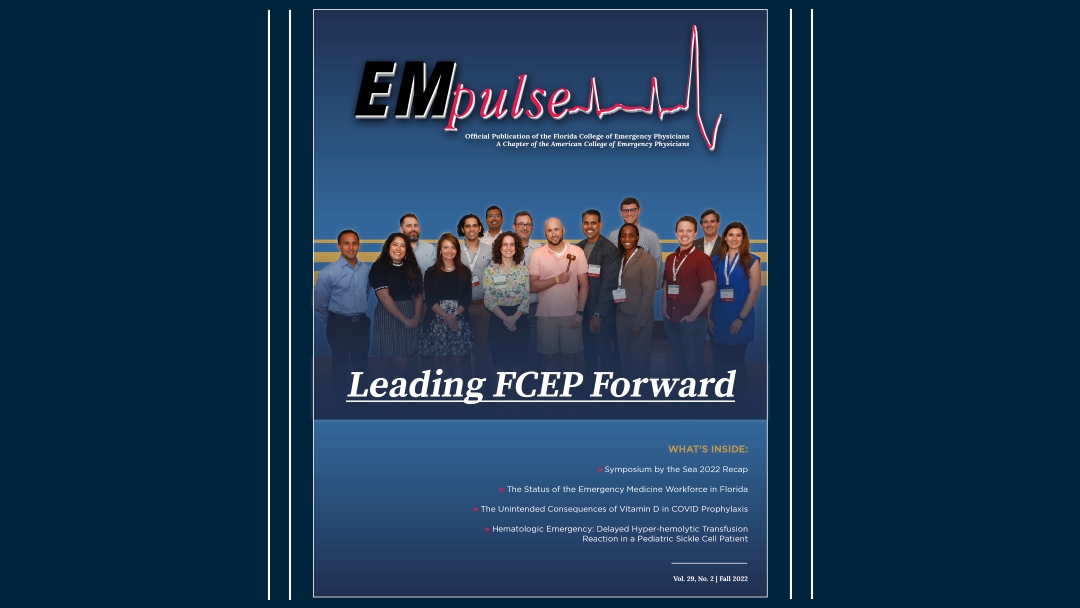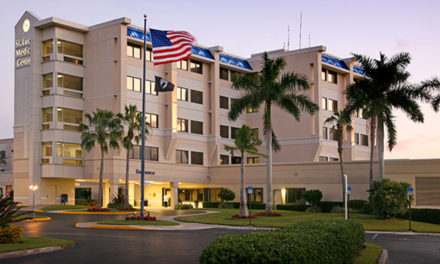Fall 2022: The Status of the Emergency Medicine Workforce in Florida
The status of current and future emergency physician workforce needs in the United States continues to be a subject of heated debate. The American College of Emergency Physicians and others have projected an oversupply of emergency physicians in the next decade. [1] In addition to the increased use of advanced practice professionals in U.S. emergency departments (EDs), a major component of the projected oversupply is attributed to recent increases in the number of emergency medicine residency training programs. [2] However, an oversupply of emergency physicians in the next decade may not necessarily equate to an oversupply in all regions of the country. [3]
Since 2008, the number of programs in large cities has grown disproportionately when compared with the flat or declining growth of programs based in rural regions of the country. [4] According to 2020 American Medical Association data, 98% of emergency medicine residents were in urban areas [4] — specifically, 6,850 in urban areas, 114 in large rural areas, and 23 in small rural areas. [5]
According to ACGME data, over a seven-year period, the number of emergency medicine residency programs in the U.S. grew from 160 (2013) to 247 (2020). [4] These new, 3-year training programs were disproportionately added to states with an already high number of programs: Florida (6 to 21), Michigan (11 to 25), New York (21 to 31), Ohio (9 to 18), Pennsylvania (12 to 21), California (14 to 22). Several, mostly rural, states had no emergency medicine residency programs in 2020: Alaska, Hawaii, Idaho, Montana, North Dakota, South Dakota, and Wyoming. This is contributing to an emergency physician “desert” in these states and a wide variation in the supply of emergency physicians, particularly in rural areas, despite the growing number of programs. [3]
Observed changes in emergency physician densities and regional variation in supply could mean that urban markets will experience a higher degree of emergency physician saturation while rural markets suffer from an ongoing unmet demand for emergency physicians. Trends in the emergency medicine resident physician population and where these residents are training will likely impact future trends in where the clinically active emergency physician will practice.
Florida has long been a “bellwether” state for trends in healthcare due to its aging population, its changing diversity, and its fast-growing urban areas. To provide a better overall understanding of the dynamic changes in the Florida emergency physician landscape, we report below on the status of the current emergency physician workforce in Florida.
2021 Florida Physician Workforce Annual Report
The 2021 Physician Workforce Annual Report [3] is based on responses to the Florida Physician Workforce Survey. The survey is part of the licensure renewal process for physicians and is administered by the Florida Department of Health’s Division of Medical Quality Assurance. Physicians must renew their license every other year. Newly licensed physicians are not included in the analysis because the survey is only administered upon licensure renewal.
Florida Physician Workforce Practice Characteristics
Over the last 10 years, the number of practicing physicians in all specialties increased 24%, from 44,804 to 55,809. However, the growth in practicing emergency physicians was 40%, with 2,344 in 2012-13 and 3,279 in 2020-21. During this same time, the population of Florida increased 13.5%, from 19.3 million to 21.9 million.
Emergency medicine is the sixth largest specialty group in Florida following internal medicine (15,339), family medicine (7,951), pediatrics (4,441), surgery (4,132), and anesthesiology (3,348). The number of emergency physicians in Florida continues to grow, with the most recent one-year increase being 3%. It will continue to grow as additional residency programs have been approved and as newly credentialed emergency physicians renew their license after passing their boards.
Emergency medicine has the largest percentage of physicians under age 40 (25.2%). It also had the lowest percentage of physicians age 60-69 (15.7%) and 70 and over (5.8%). Despite their comparatively younger age range, the number of emergency physicians who plan to retire in the next five years was 300 (9.2%), which is the same percentage as the overall physician retirement rate in Florida.
Nearly 18% of emergency physicians surveyed reported they had relocated to Florida within the last five years. Of these, just over half stated it was for employment opportunities or employment after finishing their residency. Additionally, emergency medicine had the highest percentage of physicians planning to relocate out of Florida within the next five years: 11.6%, compared with 4.7% (2,464) of all Florida physicians who answered the question in the 2020-21 survey cohort.
Physician Workforce Advisory Council
The Physician Workforce Advisory Council was established in section 381.4018, Florida Statutes, and is charged with advising the State Surgeon General and the Florida Department of Health about the current and future physician workforce needs in the state. [3] The Council is comprised of medical and academic stakeholders and serves as a coordinating and strategic planning body to assess the state’s physician workforce needs.
The Council also monitors the status of Graduate Medical Education (GME) programs in Florida, which are an important component of Florida’s physician workforce. In 2013, the Florida Legislature created the Statewide Medicaid Residency Program and appropriated $80 million to the program in the form of recurring state and matching federal funds. In 2015, the Legislature also created the GME Startup Bonus Program to provide resources for educating and training physicians in specialties that are in a statewide supply-and-demand deficit — a list that included emergency medicine — and appropriated $100 million to the program. In 2020, the Legislature appropriated a total of $287.6 million to these programs. Emergency medicine was removed from the list of “shortage” specialties last year, but the growth of emergency residencies programs continues with the ACGME approval of two new programs within the past year.
The Physician Workforce Advisory Council issued the following relevant recommendations in the 2021 annual report: [3]
- Going forward, the Council recommends collaborating with the Council of Florida Medical School Deans to develop and maintain a comprehensive database of current GME residency positions in Florida including emergency medicine. Their goal will be to measure the current and projected areas of need. In 2021, the GME Working Group determined that in 2020–2021, there were 7,608 residency and fellowship slots in the state, which is 1,761 more slots than in 2016–2017. A disproportionate growth in the number of emergency medicine resident slots was noted, which led to the specialty’s removal from the ”shortage specialty” list.
- The Council will more carefully evaluate new models that forecast physician and subspecialty needs in Florida. The anticipated 2022 Florida Statewide and Regional Physician Workforce Analysis provided by the Safety Net Hospital Alliance of Florida will be reviewed.
- The Council will review and revise its strategic plan, including emergency physician workforce issues. The list of accomplished objectives for the growth of emergency medicine residency programs was completed; objectives in process will be updated, and the need for new objectives will be evaluated.
- The Council will determine how to best review the impact and quality of the new and existing GME programs, including emergency medicine. New metrics are being developed to assess the impact and quality of all GME programs.
- The Council has recommended that the Legislature direct the Agency for Health Care Administration to seek resident physician specialty board pass-rate by program. These data will allow for comparisons between programs and foster the exchange of best practices with the goal of having the best GME residency programs in the U.S.
Conclusion
It will be important to review and assess current and future emergency physician workforce needs in Florida. Physician workforce assessment and planning by the Florida Agency for Healthcare Planning will result in new information for policymakers on clinical practice and geographic location for Florida emergency physicians. The Florida College of Emergency Physicians has started a Workforce Task Force to closely follow this issue as well. The continuing refinement, evaluation and reporting of this information will assist in the state’s efforts to meet current and future workforce needs.
A summary of key information for policy consideration includes:
- During the last 10-year period, the total number of practicing physicians increased over 24%. The number of practicing emergency physicians increased 40%. During this same time, the population of Florida increased only 15%.
- Physicians are generally concentrated in populous counties and within large, urban population centers. Physicians working in rural areas are more likely to be primary care providers. Survey results indicated that 98% of emergency physicians work in urban counties while 2% work in Florida’s 30 rural counties.
- Emergency physician gender and ethnic diversity of Florida’s emergency physician workforce has increased. The percentage of female physicians has increased from 24.4% in 2013 to 28.9% in 2021, and the percentage of Hispanic, Asian, Black and Native American physicians has increased by 6.2% over the same period.
- Each year physicians report if they are planning to retire or move out of the state. Even though emergency medicine is the youngest specialty among Florida physicians, the percentage of emergency physicians who reported plans to retire within the next five years increased to 9.2% in 2020–21. Emergency medicine was third among specialties with the highest percentages of those planning to move to another state (11.6%). ■
References
- Marco C.A., Courtney D.M., Ling L.J, et al. The emergency medicine physician workforce: projections for 2030. Ann Emerg Med. 2021; 78: 726-737
- Reiter M, Allen BW. The emergency medicine workforce: shortage resolving, future surplus expected. J Emerg Med. 2020; 58: 198-202.
- https://www.ama-assn.org/about/masterfile/ama-physician-masterfile
- https://www.acgme.org/about-us/publications-and-resources/graduate-medical-education-data-resource-book/
- https://www.healthleadersmedia.com/clinical-care/rural-areas-experiencing-emergency-medicine-workforce-shortage
- https://www.floridahealth.gov/provider-and-partner-resources/community-health-workers/HealthResourcesandAccess/physician-workforce-development-and-recruitment/2021DOHPhysicianWorkforceAnnualReport-FINALREPORT-10-25-2021.pdf







